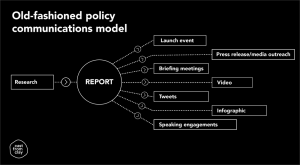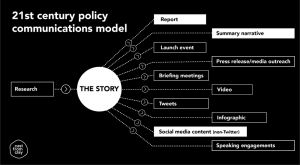[The summary of this session was written by Erika Perez-Leon, Director of Communications at On Think Tanks.]
In the age of social media, facts are in crisis. But policy-making is not just about facts — it is also about how they interact with the political environment. This session, run by Aidan Muller and Katy Murray from Cast From Clay, looks beyond fact-based communications. It defines the terms of engagement, and explores what a viable model of storytelling might look like for think tanks. Aidan and Katy are joined by Lizzie Harvey, who talks about some of the storytelling work she has done at Theos think tank.
Speakers: Aidan Muller and Katy Murray (Cast from Clay), Lizzie Harvey (Theos think tank)
Key takeaways
This session builds on these two slides that Cast from Clay presented two years ago, considering more recent conversations around narratives and storytelling.


The slides show the standard model of think tank communications (with the report at the heart of all communications activity and a number of activations that follow) and the 21st century policy communications model, which focused on the story rather than the report (seeing the report as one more communication asset).
How to start to define a framework for storytelling?
- Embrace the new policy dynamic. Up to 10 or 15 years ago policy experts only really had to focus on policymakers and mainstream media. These set the policy agenda, and the public remained a passive actor. This changed with social media, which gave the public a voice. It’s messy, but it’s quite a powerful force. This shifted from a bi-power dynamic to a tri-power dynamic where commentary and opinion are as valid as news, and emotions are just as valid as facts. What policymakers want from academics and experts are frameworks to help them understand the complex world that they live in and put simply, they want the stories.
- Take people as they are rather than as we want them to be. People are more likely to remember stories than they are facts. This is about the role that facts play within the wider practice of storytelling. One of the main findings of cognitive science is that people think in terms of frames and metaphors. So, when the facts don’t fit frames, the frames are kept but the facts are ignored. This is a challenge for all of us who believe in facts and evidence, particularly in policymaking.
Use storytelling to tap into the human.
- A think tank model of storytelling. What’s the difference between stories and narratives? Stories are the things that happen to people, narratives are shaped by a collection of stories. Narratives occur at personal level, at community level, and they also occur at societal level. Crucially, narratives have a direction of travel, and they work as a curating filter. When stories don’t fit within a narrative, they are simply filtered out. This is why narrative change is so hard to achieve.
Storytelling exists as two levels for think tanks:
- The message: where your research exists, the human story behind the data
- The environment: this is where the narrative plays in. What does your world look like?
Is this outside the remit of think tanks? Cast from Clay asked 100 members of the UK parliament what they thought the role of a think tank should be today:
- One in three of them said that think tanks do enough to explain policy ideas to the public
- Over half of them thought that think tanks need to do more and have a duty beyond publishing reports to articulate their vision of society.
Aidan then presented a framework for storytelling for think tanks.
Lizzie Harvey, from Theos think tank, talked about their work around enriching the conversation and belief in society, believing there is untapped wisdom in faith traditions that can speak into some of the big questions about how we live well today.
The prevailing narrative around faith and believe is not always a positive one, so this requires a certain level of environmental storytelling.
Lizzie shared four case studies:
- ‘The sacred podcast’: set out to find a way to find more productive, less combative ways to think about our divides. This related to stortytelling because they started to tell a different story around faith and believe
- ‘Forgive us our debts’: a report which looked to tell the human story of debt.
- ‘Growing good’: a report that is about promoting social action through churches by telling the human stories.
- ‘Religion and worldviews report’: religious education in schools is outdated and there has to be a better way to think about faith and belief.
Lizzie then shared the experience of Theos think tank in growing their comms team and the balance between researchers and communicators.
From the chatbox
Resources
Democracy 2.0: a new role for the policy expert?
Why think tanks should employ fewer researchers, by Louise Ball
The Perils of Perception: Why We’re Wrong About Nearly Everything, by Bobby Duffy
Don’t Think of an Elephant! Know Your Values and Frame the Debate: The Essential Guide for Progressives, by George Lakoff


 Previous
Previous
